Impacts of Water Flow Rate on Freezing Prevention of Air-Cooled Heat Exchangers in Power Plants
Abstract
:1. Introduction
2. Models
2.1. Geometric Model
2.2. Numerical Model
- (1)
- Flow acceleration effects are neglected in calculating the pressure loss coefficient;
- (2)
- Auxiliary fluid flow is assumed to be 1D.
2.3. Mesh Approach and Boundary
2.4. Validation of Numerical Model
3. Results and Discussion
3.1. Freezing Analysis
3.2. Impacts of Water Flow Rate
4. Conclusions
Acknowledgments
Author Contributions
Conflicts of Interest
Nomenclature
| cp | specific heat (J·Kg−1·K−1) |
| e | exponent in the power-law equation of wind speed |
| f | pressure loss coefficient |
| m | mass flow rate (kg·s−1) |
| p | pressure (Pa) |
| Q | heat rejection (W) |
| S | source term in generic equation |
| t | temperature (K) |
| u | velocity (m·s−1) |
| v | specific volume (m3·kg−1) |
| xj | coordinate in j direction (m) |
| z | height above the ground (m) |
| Greek symbols | |
| εQ | heat exchanger effectiveness |
| Г | diffusion coefficient (m2·s−1) |
| φ | scalar variable |
| ρ | density (kg·m−3) |
| Subscripts | |
| a | air |
| Amin | minimum flow area |
| w | water |
| wd | wind |
References
- Kroger, D.G. Air-Cooled Heat Exchangers and Cooling Towers: Thermal-Flow Performance Evaluation and Design; Penn Well Corporation: Tulsa, OK, USA, 2004. [Google Scholar]
- Kong, Y.Q.; Xi, X.M.; Dong, Z.W.; Du, X.Z.; Yang, L.J. Thermal-hydraulic and anti-freezing performances of heat exchanger of 600 MW indirect dry cooling systems. J. Eng. Thermophys. 2015, 36, 1785–1789. [Google Scholar]
- Li, Y.J.; Wu, X.L.; An, J.X.; Liu, J.; Luo, Y. Study on anti-freezing technology of indirect air cooling condenser system in cold and high altitude region. North China Electr. Power 2013, 14, 22–26. [Google Scholar]
- Wang, W.J.; Yang, L.J.; Du, X.Z.; Yang, Y.P. Anti-freezing water flow rates of various sectors for natural draft dry cooling system under wind conditions. Int. J. Heat Mass Transf. 2016, 102, 186–200. [Google Scholar] [CrossRef]
- Wang, W.J.; Kong, Y.Q.; Huang, X.W.; Yang, L.J.; Du, X.Z.; Yang, Y.P. Anti-freezing of air-cooled heat exchanger by switching off sectors. Appl. Therm. Eng. 2017, 120, 327–339. [Google Scholar] [CrossRef]
- Chen, L.; Yang, L.J.; Du, X.Z.; Yang, Y.P. Anti-freezing of air-cooled heat exchanger by air flow control of louver in power plants. Appl. Therm. Eng. 2016, 106, 537–550. [Google Scholar] [CrossRef]
- Wang, W.J.; Huang, X.W.; Yang, L.J.; Du, X.Z.; Yang, Y.P. Anti-freezing operation strategies of natural draft dry cooling system. Int. J. Heat Mass Transf. 2018, 118, 165–170. [Google Scholar] [CrossRef]
- Liu, P.Z.; Yang, Z.J. Anti-freezing and pre-heating measures for radiators in indirect air-cooling units in cold areas. Electr. Power 2013, 46, 18–22. [Google Scholar]
- Ma, H.; Si, F.Q.; Li, L.; Yan, W.S.; Zhu, K.P. Effects of ambient temperature and crosswind on thermo-flow performance of the tower under energy balance of the indirect dry cooling system. Appl. Therm. Eng. 2015, 78, 90–100. [Google Scholar] [CrossRef]
- Lu, Y.; Guan, Z.; Gurgenci, H.; Hooman, K.; He, S.; Bharathan, D. Experimental study of crosswind effects on the performance of small cylindrical natural draft dry cooling towers. Energy Convers. Manag. 2015, 91, 238–248. [Google Scholar] [CrossRef]
- Yang, L.J.; Chen, L.; Du, X.Z.; Yang, Y.P. Effects of ambient winds on the thermo-flow performances of indirect dry cooling system in a power plant. Int. J. Therm. Sci. 2013, 64, 178–187. [Google Scholar] [CrossRef]
- Yang, L.J.; Wu, X.P.; Du, X.Z.; Yang, Y.P. Dimensional characteristics of wind effects on the performance of indirect dry cooling system with vertically arranged heat exchanger bundles. Int. J. Heat Mass Transf. 2013, 67, 853–866. [Google Scholar] [CrossRef]
- Zhao, Y.B.; Long, G.Q.; Sun, F.Z.; Li, Y.; Zhang, C.J. Numerical study on the cooling performance of dry cooling tower with vertical two-pass column radiators under crosswind. Appl. Therm. Eng. 2015, 75, 1106–1117. [Google Scholar] [CrossRef]
- Zhao, Y.B.; Sun, F.Z.; Li, Y.; Long, G.Q.; Yang, Z. Numerical study on the cooling performance of natural draft dry cooling tower with vertical delta radiators under constant heat load. Appl. Energy 2015, 149, 225–237. [Google Scholar] [CrossRef]
- Goodarzi, M.; Keimanesh, R. Heat rejection enhancement in natural draft cooling tower using radiator-type windbreakers. Energy Convers. Manag. 2013, 71, 120–125. [Google Scholar] [CrossRef]
- Chen, L.; Yang, L.J.; Du, X.Z.; Yang, Y.P. Performance improvement of natural draft dry cooling system by interior and exterior windbreaker configurations. Int. J. Heat Mass Transf. 2016, 96, 42–63. [Google Scholar] [CrossRef]
- Gu, H.F.; Wang, H.J.; Gu, Y.Q.; Yao, J.N. A numerical study on the mechanism and optimization of wind-break structures for indirect air-cooling towers. Energy Convers. Manag. 2016, 108, 43–49. [Google Scholar] [CrossRef]
- He, S.Y.; Gurgenci, H.; Guan, Z.Q.; Alkhedhair, A.M. Pre-cooling with Munters media to improve the performance of natural draft dry cooling towers. Appl. Therm. Eng. 2013, 53, 67–77. [Google Scholar] [CrossRef]
- Goodarzi, M. Proposing a new technique to enhance thermal performance and reduce structural design wind loads for natural drought cooling tower. Energy 2013, 62, 164–172. [Google Scholar] [CrossRef]
- Liao, H.T.; Yang, L.J.; Du, X.Z.; Yang, Y.P. Influences of height to diameter ratios of dry-cooling tower upon thermo-flow characteristics of indirect dry cooling system. Int. J. Therm. Sci. 2015, 94, 178–192. [Google Scholar] [CrossRef]
- Goodarzi, M.; Keimanesh, R. Numerical analysis on overall performance of Savonius turbines adjacent to a natural draft cooling tower. Energy Convers. Manag. 2015, 99, 41–49. [Google Scholar] [CrossRef]
- Liao, H.T.; Yang, L.J.; Du, X.Z.; Yang, Y.P. Triangularly arranged heat exchanger bundles to restrain wind effects on natural draft dry cooling system. Appl. Therm. Eng. 2016, 9, 313–324. [Google Scholar] [CrossRef]
- Chen, L.; Yang, L.; Du, X.; Yang, Y. A novel layout of air-cooled condensers to improve thermo-flow performances. Appl. Eng. 2016, 165, 244–259. [Google Scholar] [CrossRef]
- Goodarzi, M.; Amooie, H. Heat transfer enhancement in a natural draft dry cooling tower under crosswind operation with heterogeneous water distribution. Int. J. Nucl. Power 2016, 61, 252–259. [Google Scholar]
- Wang, X.B.; Yang, L.J.; Du, X.Z.; Yang, Y.P. Performance improvement of natural draft dry cooling system by water flow distribution under crosswinds. Int. J. Heat Mass Transf. 2017, 108, 1924–1940. [Google Scholar] [CrossRef]
- Li, X.X.; Xia, L.; Gurgenci, H.; Guan, Z.Q. Performance enhancement for the natural draft dry cooling tower under crosswind condition by optimizing the water distribution. Int. J. Heat Mass Transf. 2017, 107, 271–280. [Google Scholar] [CrossRef]
- Launder, B.E.; Spalding, D.B. Lectures in Mathematical Models of Turbulence; Academic Press: London, UK, 1972. [Google Scholar]
- Kays, W.M.; London, A.L. Compact Heat Exchanger; McGraw Hill Co.: New York, NY, USA, 1984. [Google Scholar]
- Navarro, H.A.; Cabezas-Gómez, L. A new approach for thermal performance calculation of cross-flow heat exchangers. Int. J. Heat Mass Transf. 2005, 48, 3880–3888. [Google Scholar] [CrossRef]
- Kong, Y.Q.; Yang, L.J.; Du, X.Z.; Yang, Y.P. Effects of continuous and alternant rectangular slots on thermo-flow performances of plain finned tube bundles in in-line and staggered configurations. Int. J. Heat Mass Transf. 2016, 93, 97–107. [Google Scholar] [CrossRef]
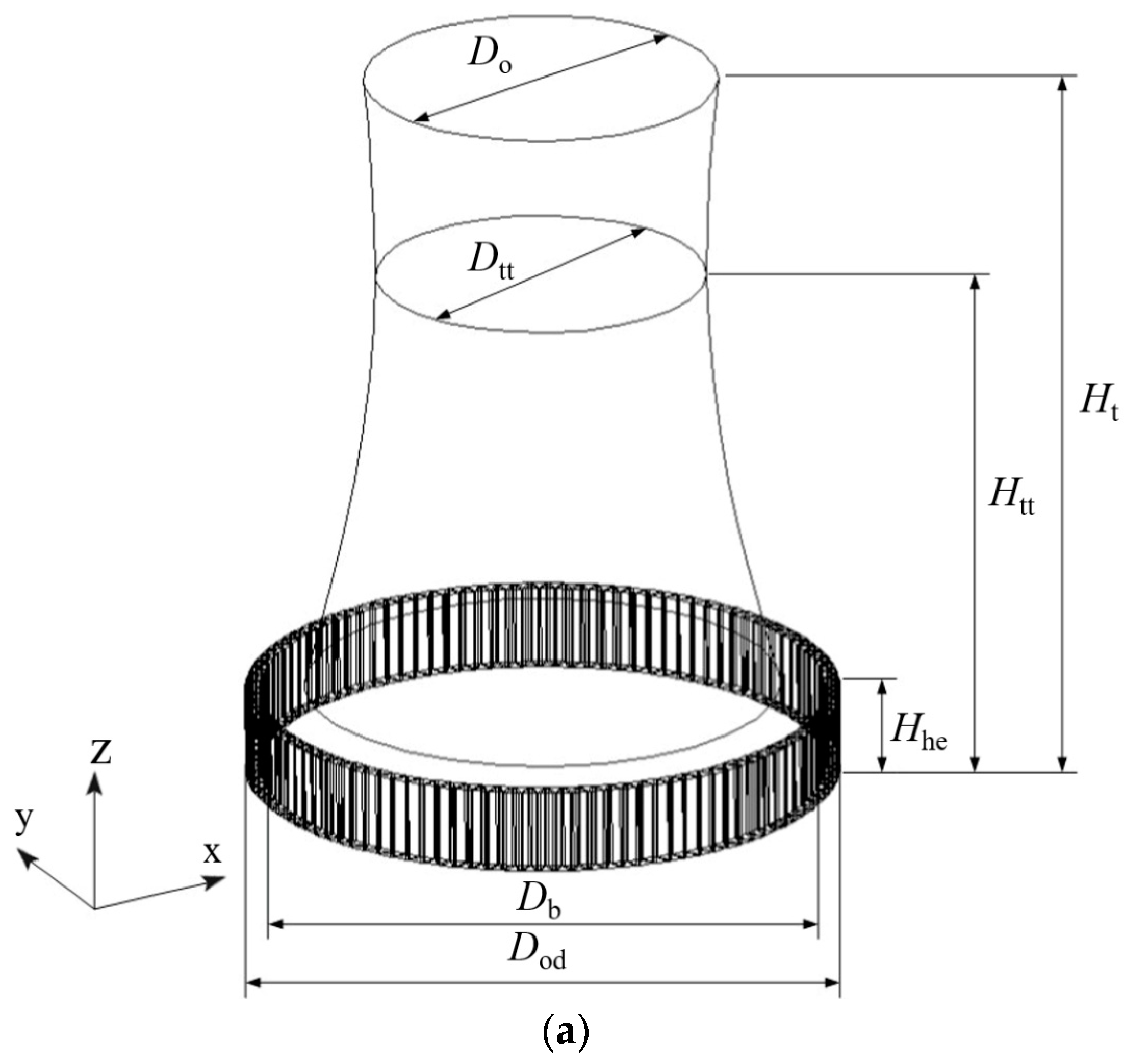
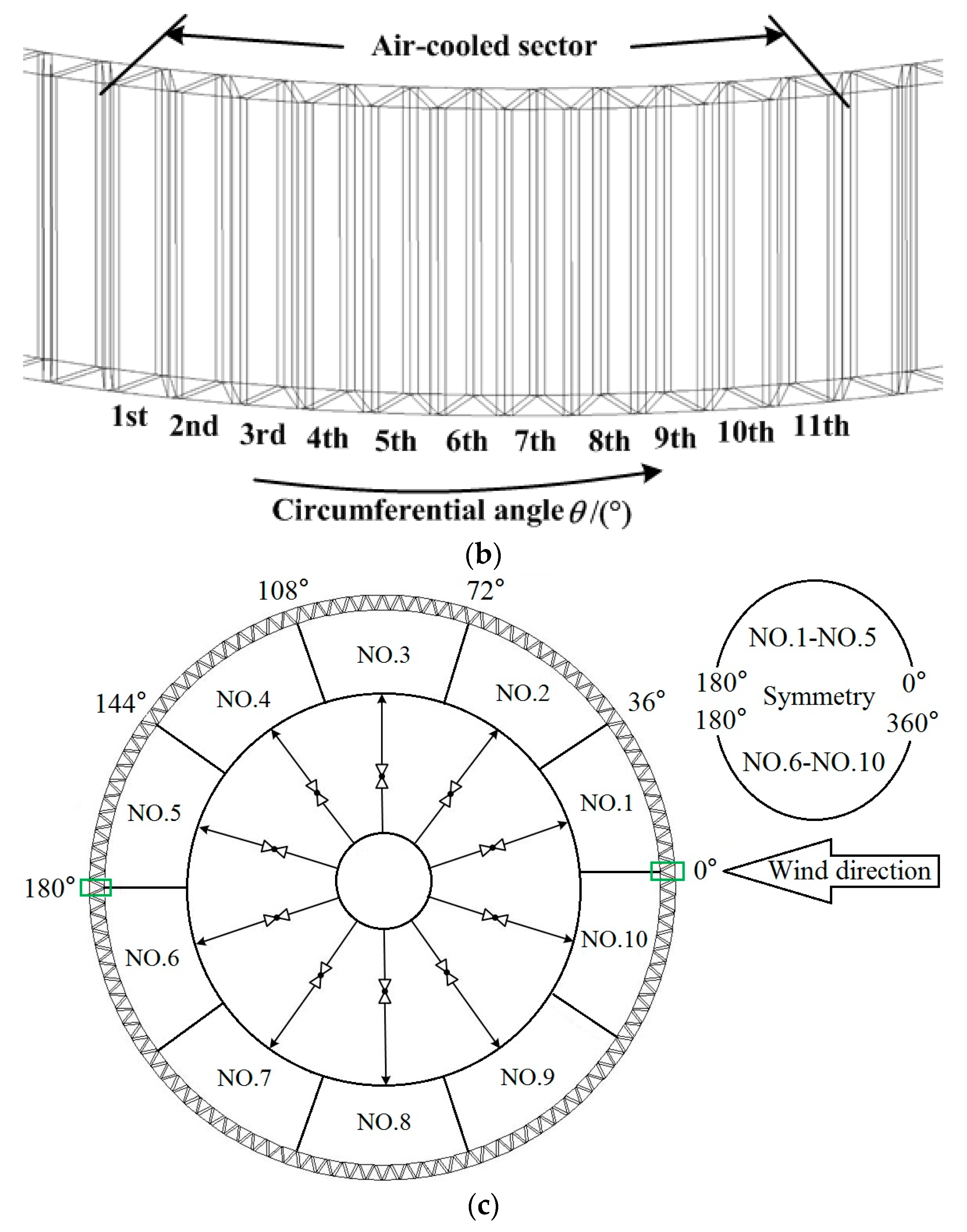
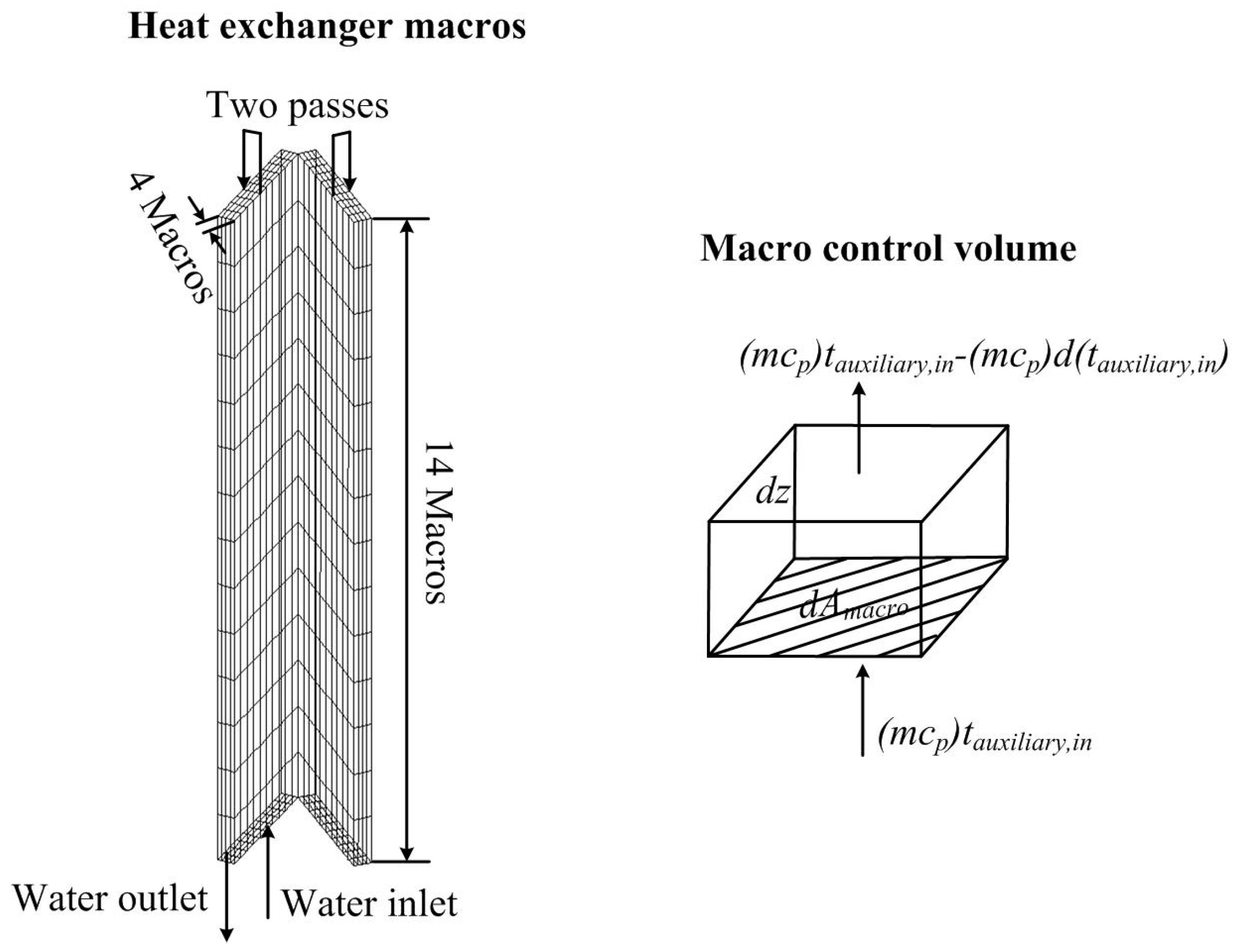
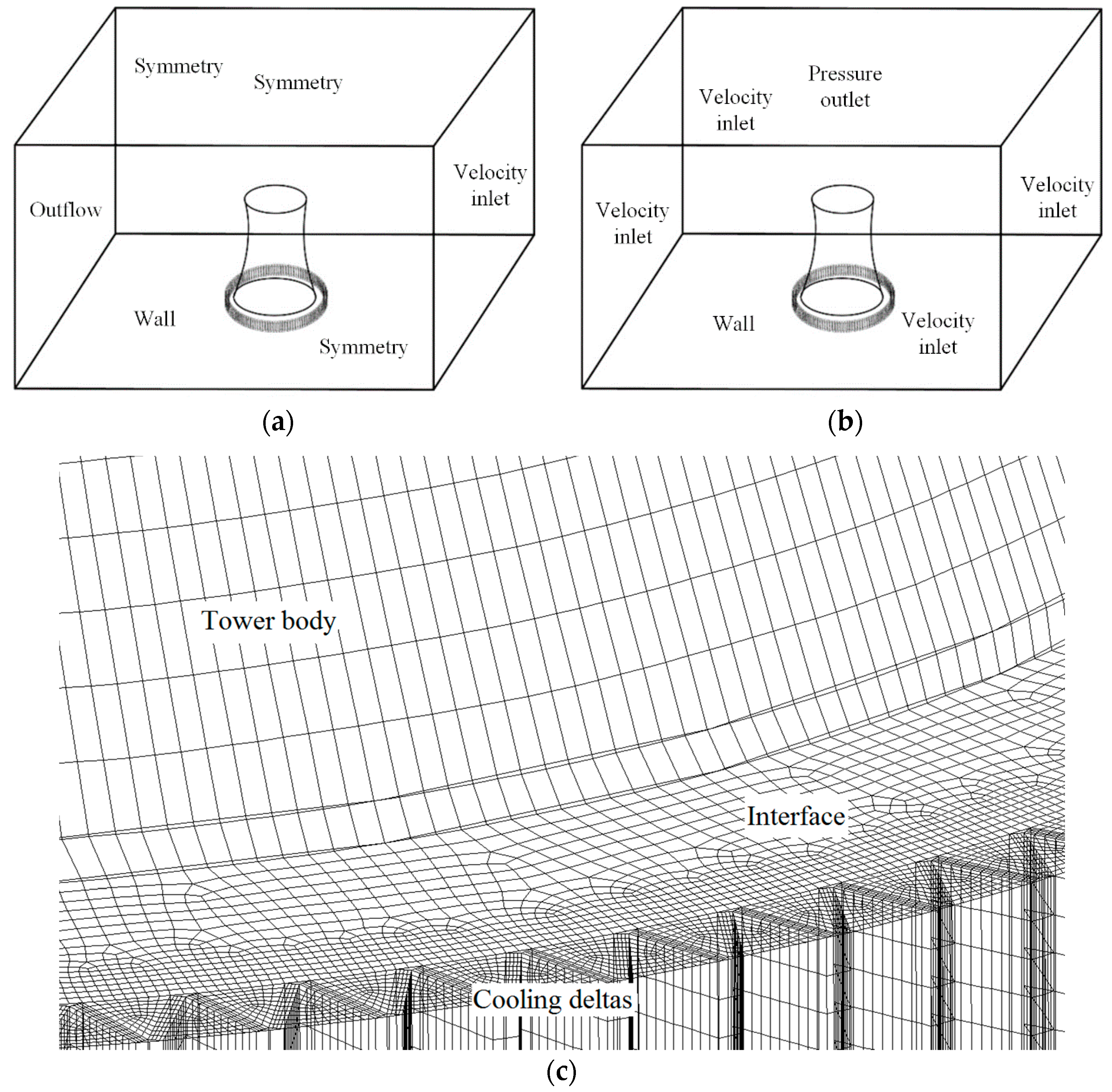
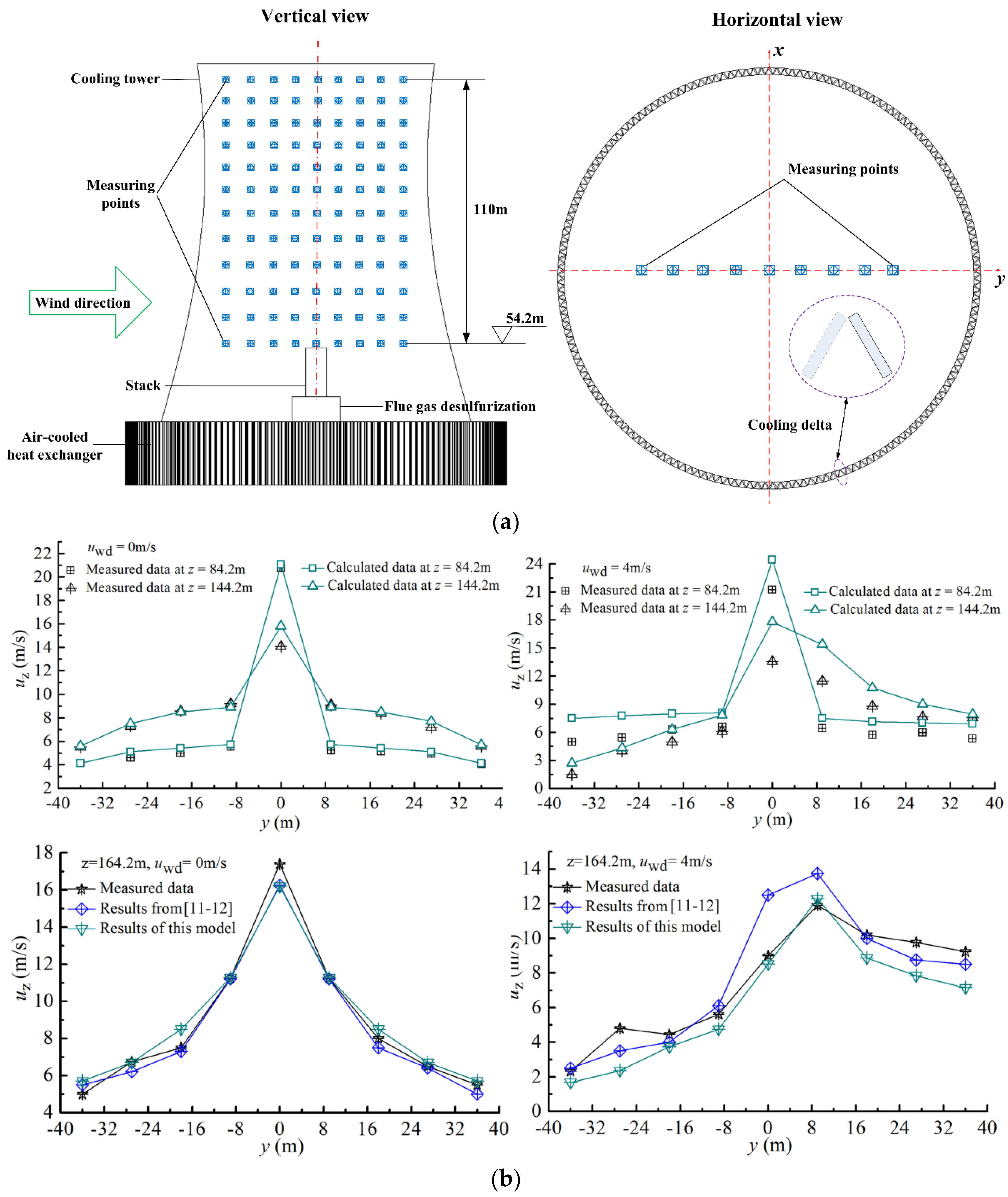
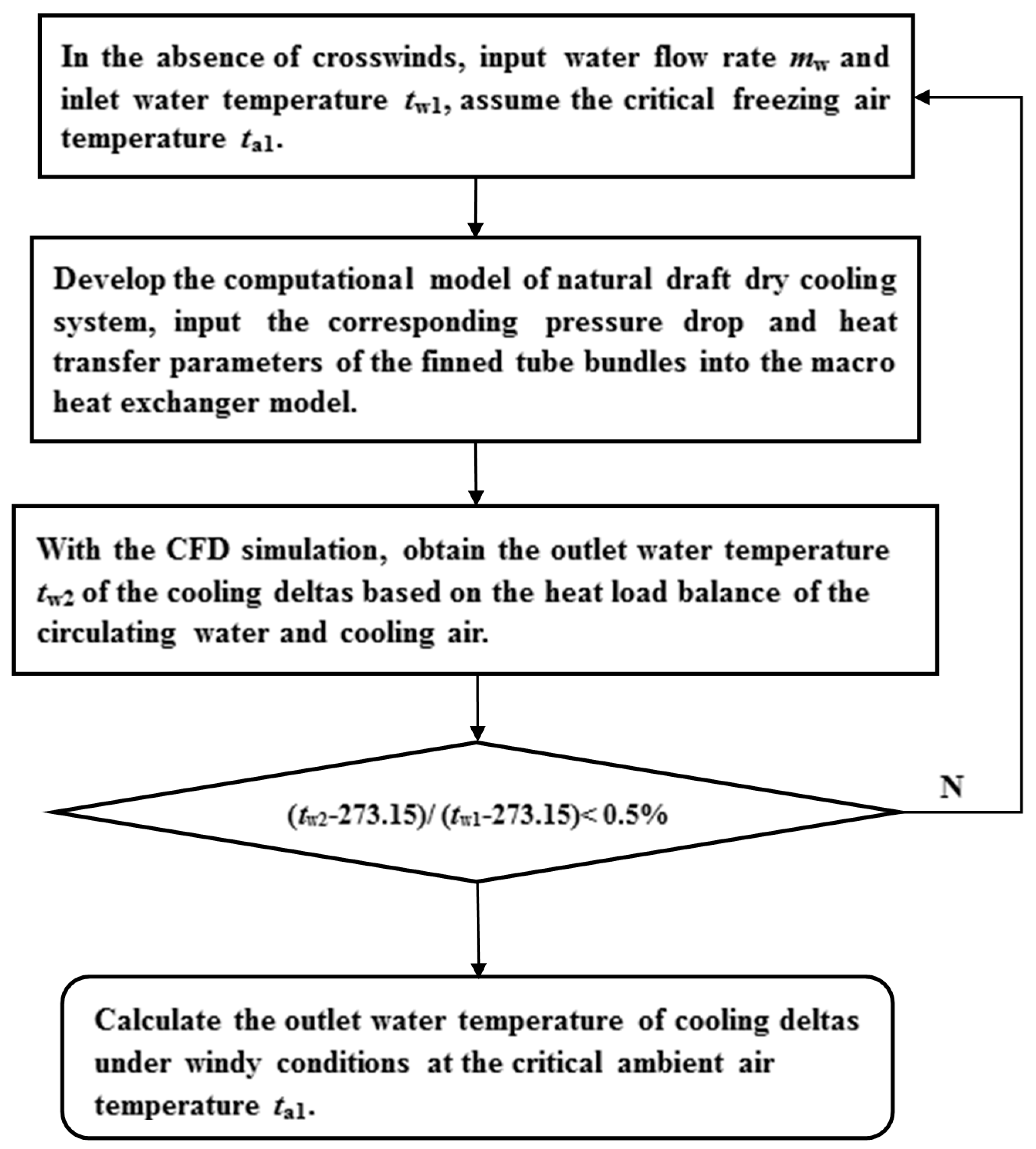
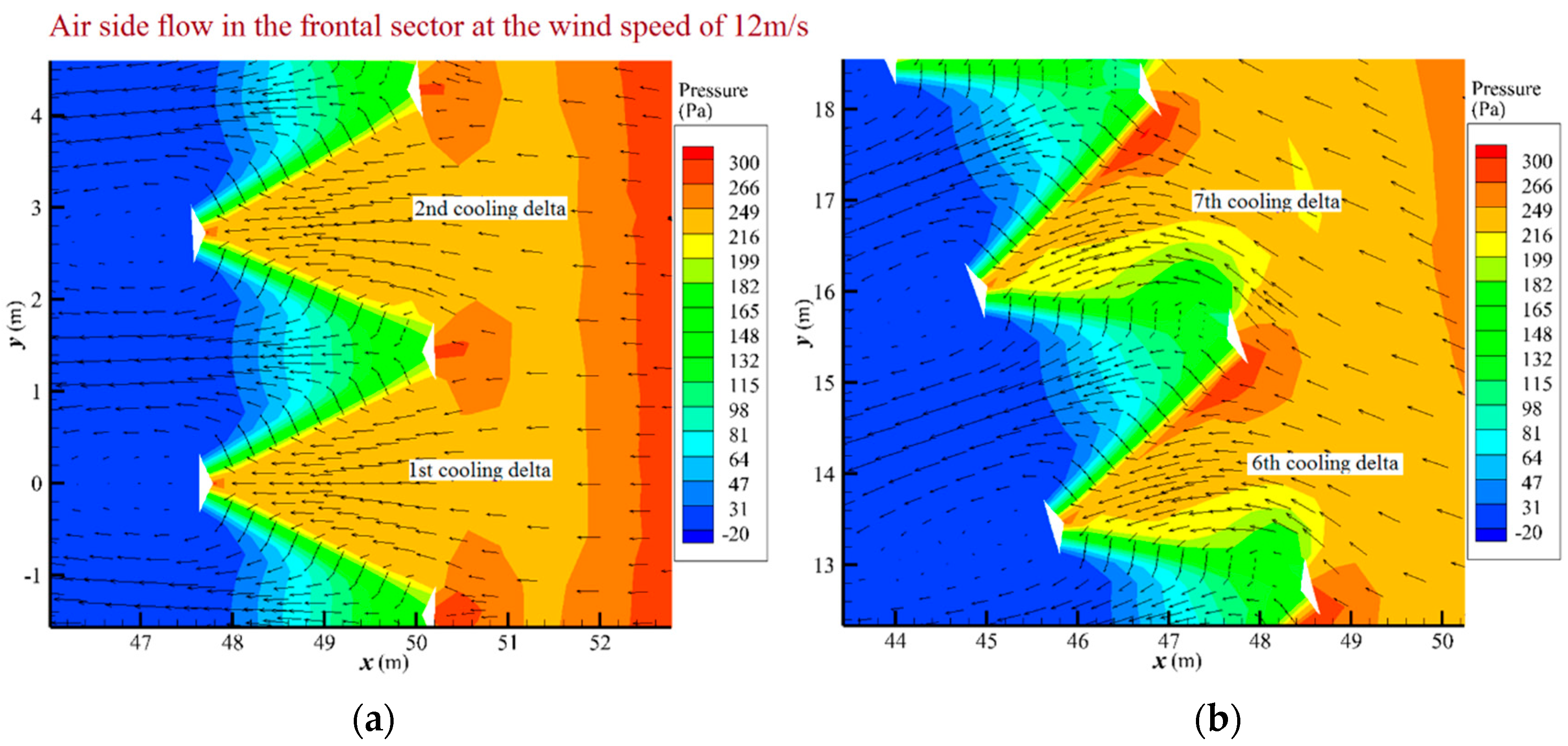
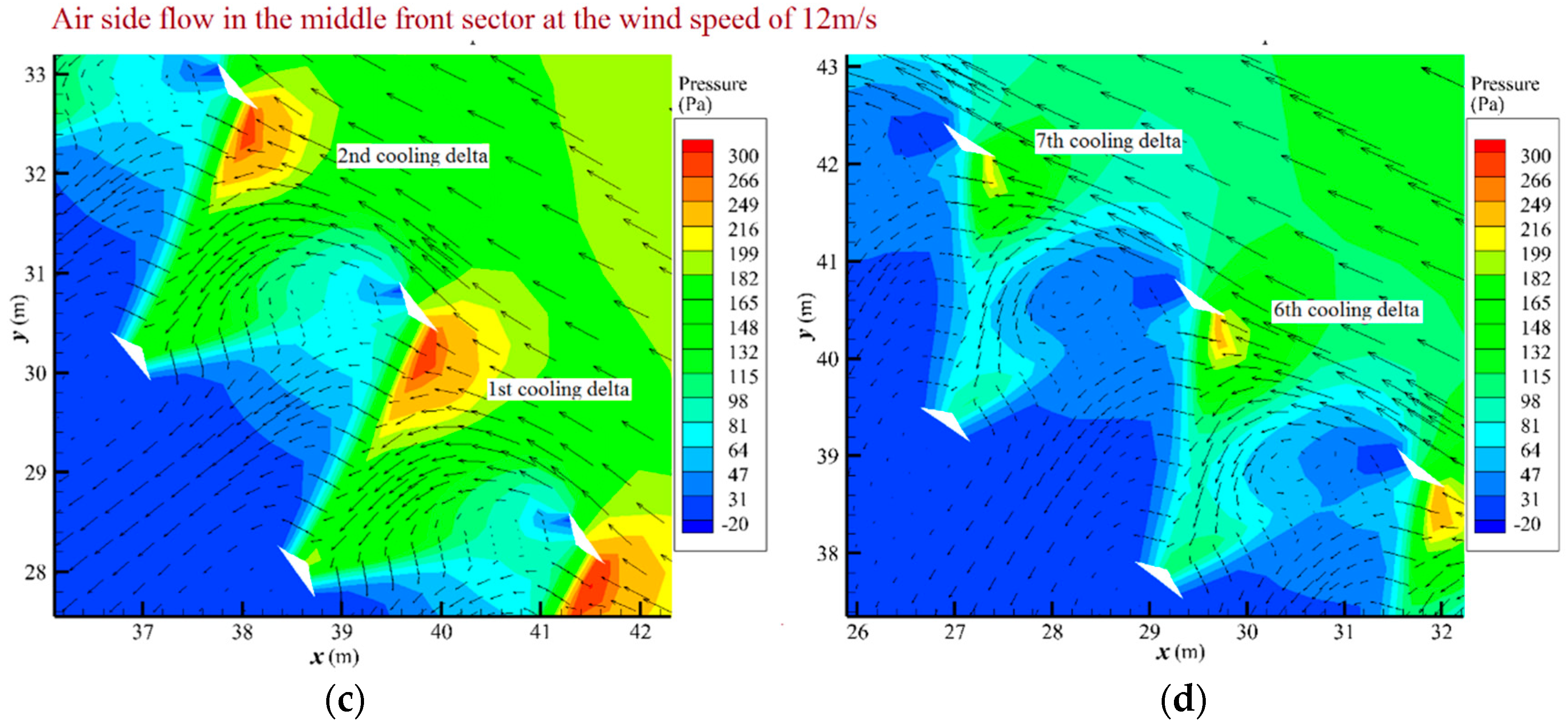
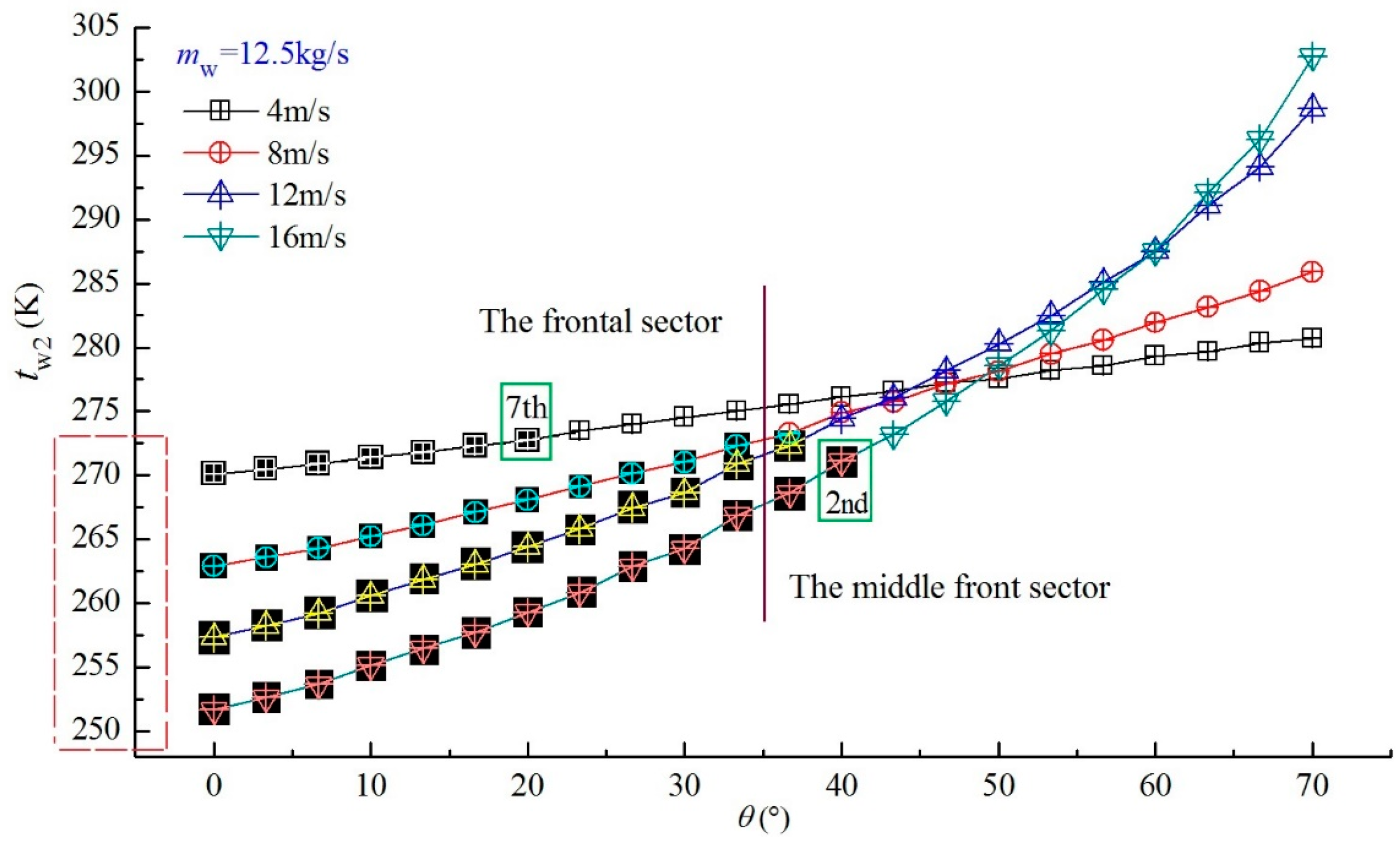
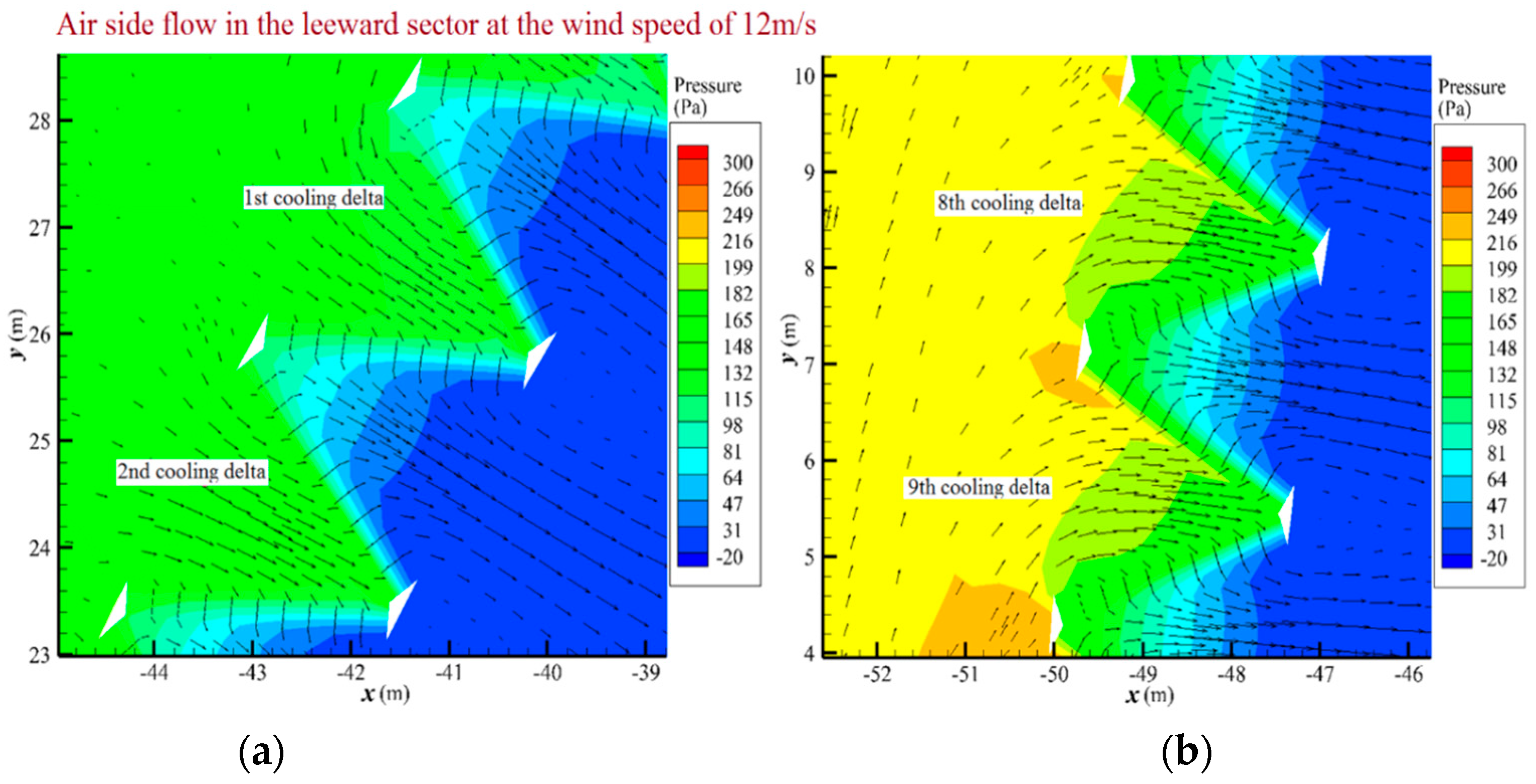

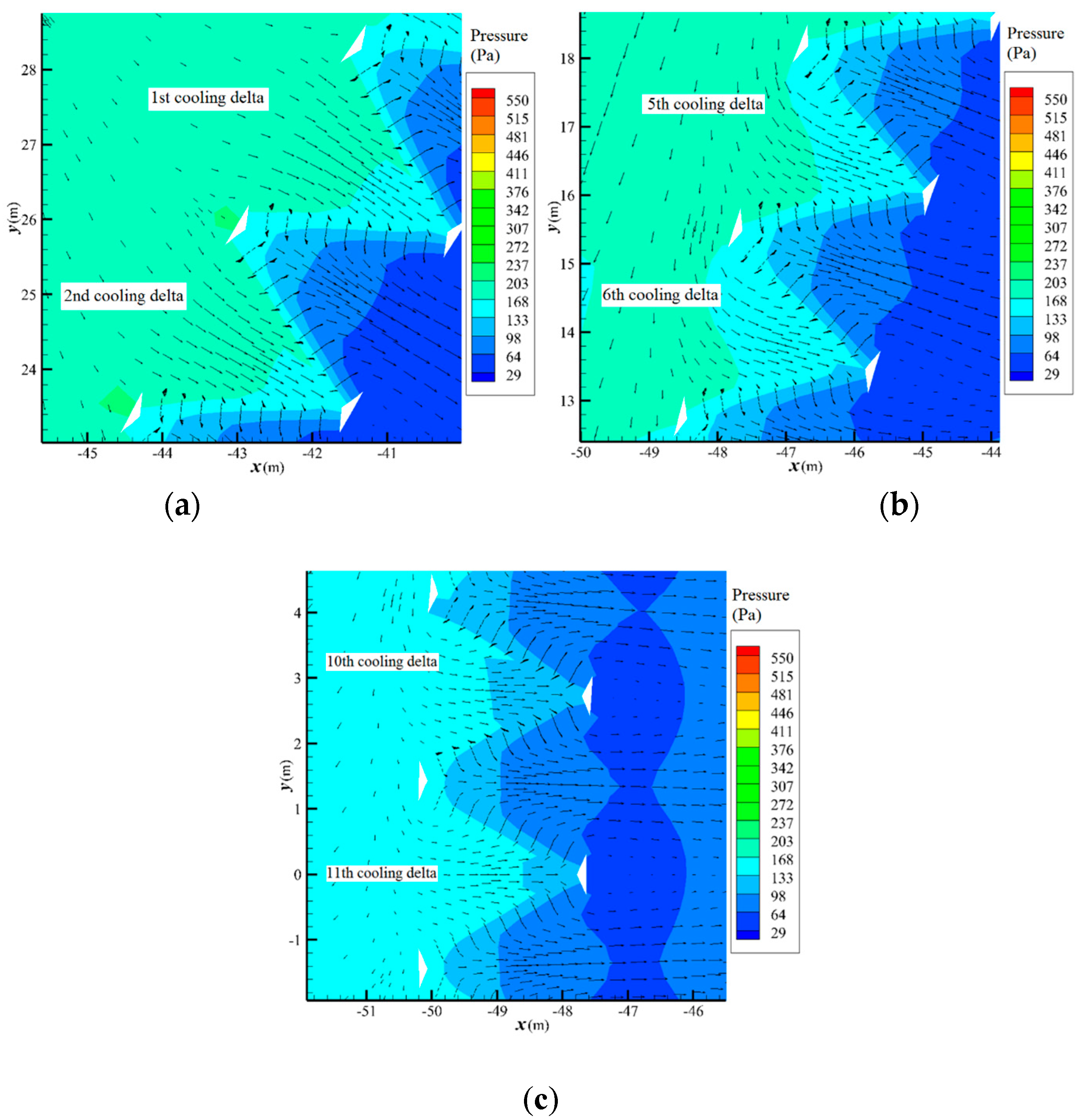
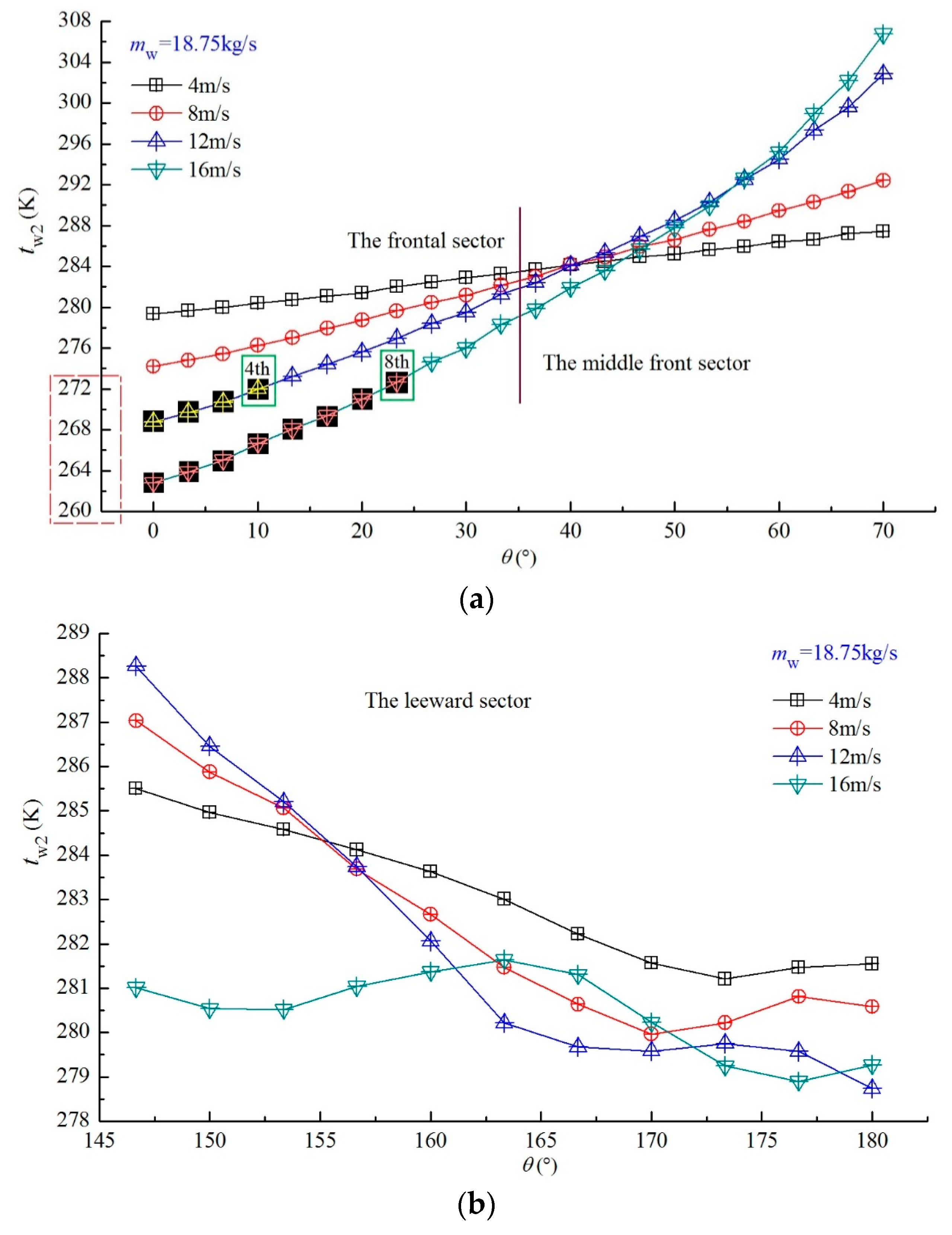


| Delta No. | 1 | 2 | 3 | 4 | 5 | 6 | 7 | 8 | 9 | 10 | 11 |
|---|---|---|---|---|---|---|---|---|---|---|---|
| frontal sector with 30% water flow rate increase | |||||||||||
| 4 m/s | 276.0 | 276.3 | 276.7 | 277.1 | 277.5 | 277.9 | 278.2 | 278.9 | 279.3 | 279.8 | 280.3 |
| 8 m/s | 270.1 | 270.7 | 271.3 | 272.2 | 272.9 | 273.9 | 274.8 | 275.8 | 276.7 | 277.4 | 278.6 |
| 12 m/s | 265.4 | 266.3 | 267.3 | 268.6 | 269.8 | 271.0 | 272.2 | 273.6 | 275.1 | 276.2 | 278.2 |
| 16 m/s | 259.4 | 260.5 | 261.6 | 263.3 | 264.7 | 266.0 | 267.6 | 269.3 | 271.3 | 272.6 | 275.1 |
| middle front sector with 30% water flow rate increase. Free from freezing | |||||||||||
| 4 m/s | 280.7 | 281.2 | 281.6 | 282.1 | 282.4 | 282.9 | 283.2 | 283.8 | 284.0 | 284.6 | 284.9 |
| 8 m/s | 279.4 | 280.8 | 281.6 | 282.8 | 283.6 | 284.8 | 285.6 | 286.8 | 287.7 | 288.8 | 290.1 |
| 12 m/s | 279.4 | 281.2 | 282.5 | 284.3 | 286.0 | 287.8 | 290.1 | 292.2 | 295.3 | 297.8 | 301.6 |
| 16 m/s | 276.7 | 278.9 | 280.7 | 283.0 | 285.3 | 287.5 | 290.4 | 293.1 | 297.2 | 300.7 | 305.9 |
| leeward sector with 30% water flow rate increase. Free from freezing | |||||||||||
| 4 m/s | 282.7 | 282.1 | 281.7 | 281.1 | 280.6 | 279.9 | 279.1 | 278.4 | 277.9 | 278.3 | 278.4 |
| 8 m/s | 284.1 | 282.8 | 281.9 | 280.3 | 279.2 | 277.9 | 277.0 | 276.5 | 276.8 | 277.3 | 276.9 |
| 12 m/s | 285.8 | 283.8 | 282.6 | 280.6 | 278.8 | 277.0 | 276.4 | 276.3 | 276.4 | 276.5 | 275.9 |
| 16 m/s | 278.6 | 278.2 | 278.2 | 278.8 | 279.1 | 279.4 | 279.2 | 278.2 | 277.3 | 277.1 | 277.9 |
| frontal sector with 40% water flow rate increase | |||||||||||
| 4 m/s | 277.7 | 278.0 | 278.4 | 278.8 | 279.1 | 279.5 | 279.9 | 280.5 | 280.9 | 281.4 | 281.8 |
| 8 m/s | 272.2 | 272.8 | 273.5 | 274.3 | 275.1 | 276.0 | 276.9 | 277.8 | 278.7 | 279.4 | 280.5 |
| 12 m/s | 266.7 | 267.6 | 268.6 | 270.0 | 271.2 | 272.4 | 273.6 | 275.0 | 276.5 | 277.6 | 279.5 |
| 16 m/s | 260.7 | 261.7 | 262.8 | 264.5 | 265.9 | 267.2 | 268.9 | 270.5 | 272.5 | 273.9 | 276.2 |
| middle front sector with 40% water flow rate increase. Free from freezing | |||||||||||
| 4 m/s | 282.2 | 282.7 | 283.1 | 283.6 | 283.8 | 284.3 | 284.6 | 285.1 | 285.3 | 285.9 | 286.2 |
| 8 m/s | 281.3 | 282.6 | 283.3 | 284.4 | 285.1 | 286.2 | 287.0 | 288.1 | 288.9 | 290.0 | 291.1 |
| 12 m/s | 280.7 | 282.4 | 283.7 | 285.4 | 287.1 | 288.9 | 291.2 | 293.2 | 296.2 | 298.6 | 302.0 |
| 16 m/s | 277.8 | 280.0 | 281.8 | 284.0 | 286.2 | 288.3 | 291.2 | 293.8 | 297.6 | 300.9 | 305.7 |
| leeward sector with 40% water flow rate increase. Free from freezing | |||||||||||
| 4 m/s | 284.1 | 283.6 | 283.2 | 282.7 | 282.2 | 281.5 | 280.7 | 280.0 | 279.5 | 279.6 | 279.8 |
| 8 m/s | 285.6 | 284.3 | 283.5 | 282.0 | 280.9 | 279.6 | 278.8 | 278.1 | 278.4 | 279.0 | 278.8 |
| 12 m/s | 286.9 | 285.0 | 283.6 | 282.1 | 280.4 | 278.5 | 277.8 | 277.6 | 277.7 | 277.7 | 277.2 |
| 16 m/s | 280.2 | 280.2 | 280.1 | 280.4 | 280.6 | 280.7 | 279.9 | 278.5 | 277.4 | 277.0 | 277.2 |
© 2018 by the authors. Licensee MDPI, Basel, Switzerland. This article is an open access article distributed under the terms and conditions of the Creative Commons Attribution (CC BY) license (http://creativecommons.org/licenses/by/4.0/).
Share and Cite
Guo, Y.; Wei, H.; Yang, X.; Wang, W.; Du, X.; Yang, L. Impacts of Water Flow Rate on Freezing Prevention of Air-Cooled Heat Exchangers in Power Plants. Energies 2018, 11, 112. https://doi.org/10.3390/en11010112
Guo Y, Wei H, Yang X, Wang W, Du X, Yang L. Impacts of Water Flow Rate on Freezing Prevention of Air-Cooled Heat Exchangers in Power Plants. Energies. 2018; 11(1):112. https://doi.org/10.3390/en11010112
Chicago/Turabian StyleGuo, Yonghong, Huimin Wei, Xiaoru Yang, Weijia Wang, Xiaoze Du, and Lijun Yang. 2018. "Impacts of Water Flow Rate on Freezing Prevention of Air-Cooled Heat Exchangers in Power Plants" Energies 11, no. 1: 112. https://doi.org/10.3390/en11010112
APA StyleGuo, Y., Wei, H., Yang, X., Wang, W., Du, X., & Yang, L. (2018). Impacts of Water Flow Rate on Freezing Prevention of Air-Cooled Heat Exchangers in Power Plants. Energies, 11(1), 112. https://doi.org/10.3390/en11010112







